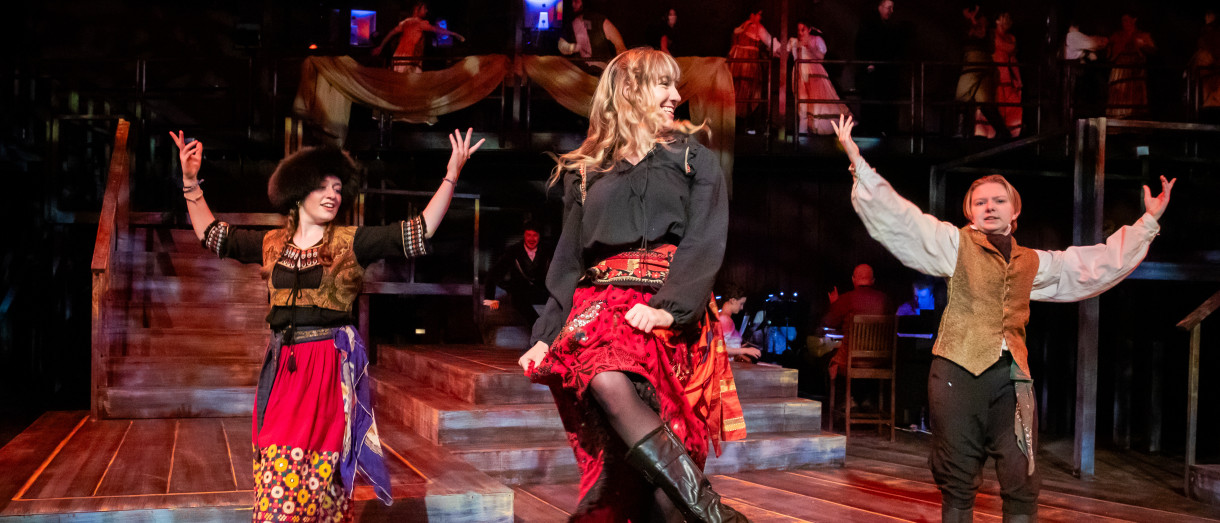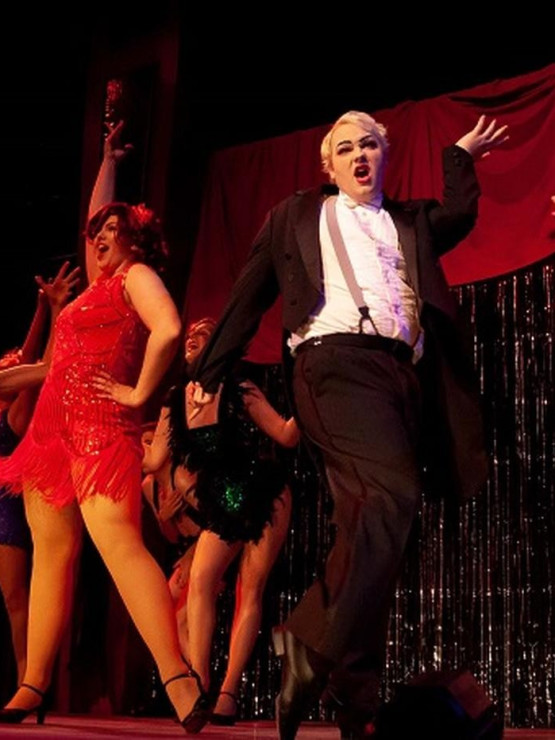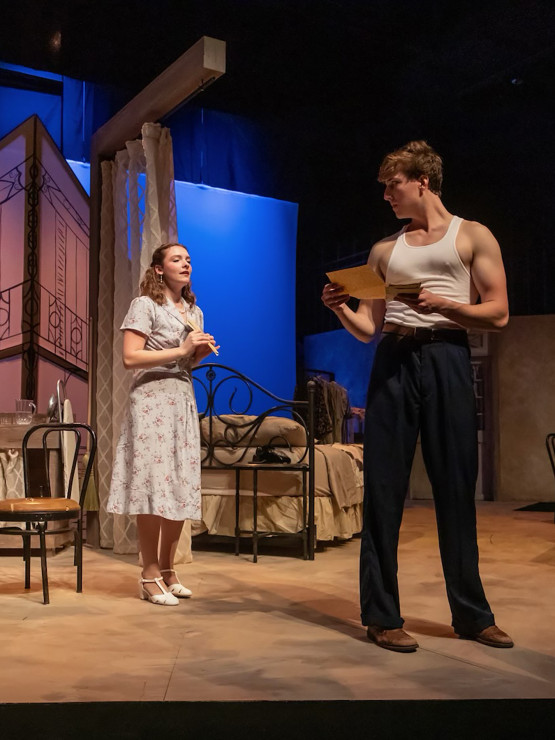Invisible Light
If Jordan Vera, lighting designer and assistant professor of theatre, has done his job right, theatergoers will leave a musical or play singing the praises of the actors, the sets, the costumes, or the writing and direction—every element of the production, that is, except the lighting. “The most beautiful lighting is lighting that’s not noticed,” says Vera. “It’s lighting that immerses you into a scene, makes you feel something, and allows you to forget that you’re in a theater with giant lights pointed at actors.”
 Where and how to point those lights in service of the desired effect is the crux of Vera’s job, and one that occurs in response to and conversation with the contributions of many other artists. As costumes are designed and created, Vera has to think about how the light will interact with the color, material, or detail of what an actor is wearing. When sets are built, Vera has to determine where and how light and shadows fall among the various walls and objects, determining in any given moment what is seen and unseen.
Where and how to point those lights in service of the desired effect is the crux of Vera’s job, and one that occurs in response to and conversation with the contributions of many other artists. As costumes are designed and created, Vera has to think about how the light will interact with the color, material, or detail of what an actor is wearing. When sets are built, Vera has to determine where and how light and shadows fall among the various walls and objects, determining in any given moment what is seen and unseen.
The actors’ performances, too, serve to shape the ultimate lighting design. Good lighting, notes Vera, amplifies the emotion an actor brings to the scene. “I can read a script 100 times and think I understand it,” says Vera, “and then an actor will read one line differently, and I can react to that with light.”
 Vera’s primary concerns have to do with the actor’s visibility and how light can sculpt the presentation of their body within the theatrical space. But color is essential to lighting’s power to heighten the emotional impact of a scene. “If it’s an angry scene, the first color you might think of is red, but there are many other colors that mean anger,” says Vera. Think, for instance, of a deep orange like that of the sky just before the sun sets. “Maybe the sun is going down and the character is getting angrier,” he says, “so I’m correlating the setting of the sun with the character’s emotion, which can really amplify a scene and help the actor get to where they need to be.”
Vera’s primary concerns have to do with the actor’s visibility and how light can sculpt the presentation of their body within the theatrical space. But color is essential to lighting’s power to heighten the emotional impact of a scene. “If it’s an angry scene, the first color you might think of is red, but there are many other colors that mean anger,” says Vera. Think, for instance, of a deep orange like that of the sky just before the sun sets. “Maybe the sun is going down and the character is getting angrier,” he says, “so I’m correlating the setting of the sun with the character’s emotion, which can really amplify a scene and help the actor get to where they need to be.”
Lighting can, in turn, also help to solve for an array of problems on set, be they technical, budgetary, or practical. In a scene set in a forest, for example, strategic shadows can evoke the idea of trees without necessitating the onstage construction of a forest. Perhaps more famously, Shakespeare’s The Winter’s Tale includes the stage direction, “Exit, pursued by a bear.” For many reasons, an actual bear may be unwise to bring into the intimate environs of a theater. But by rendering the felt presence of a bear in silhouette without the associated risk of having a performer act opposite a real one, light and shadow extend the possibilities of what can be seen and experienced in the world of live performance.
 In Vera’s view, the fact that theater events occur live, with no pause button, is what gives them such power. A performance will only occur in that setting with that audience just the one time. “It’s all about storytelling, being there in the moment, and appreciating the exchange of energy between the actors and the audience,” says Vera. And lighting, with its ability to add texture to and augment that ephemeral experience, is at its best when working in conjunction with the offerings from the dozens of other artists engaged together in realizing a production.
In Vera’s view, the fact that theater events occur live, with no pause button, is what gives them such power. A performance will only occur in that setting with that audience just the one time. “It’s all about storytelling, being there in the moment, and appreciating the exchange of energy between the actors and the audience,” says Vera. And lighting, with its ability to add texture to and augment that ephemeral experience, is at its best when working in conjunction with the offerings from the dozens of other artists engaged together in realizing a production.
“That’s really what the heart and soul of the theater is,” says Vera. “It takes a community to build, and it engages our community in stories that they could never have fathomed all on their own.”



 Where and how to point those lights in service of the desired effect is the crux of Vera’s job, and one that occurs in response to and conversation with the contributions of many other artists. As costumes are designed and created, Vera has to think about how the light will interact with the color, material, or detail of what an actor is wearing. When sets are built, Vera has to determine where and how light and shadows fall among the various walls and objects, determining in any given moment what is seen and unseen.
Where and how to point those lights in service of the desired effect is the crux of Vera’s job, and one that occurs in response to and conversation with the contributions of many other artists. As costumes are designed and created, Vera has to think about how the light will interact with the color, material, or detail of what an actor is wearing. When sets are built, Vera has to determine where and how light and shadows fall among the various walls and objects, determining in any given moment what is seen and unseen. Vera’s primary concerns have to do with the actor’s visibility and how light can sculpt the presentation of their body within the theatrical space. But color is essential to lighting’s power to heighten the emotional impact of a scene. “If it’s an angry scene, the first color you might think of is red, but there are many other colors that mean anger,” says Vera. Think, for instance, of a deep orange like that of the sky just before the sun sets. “Maybe the sun is going down and the character is getting angrier,” he says, “so I’m correlating the setting of the sun with the character’s emotion, which can really amplify a scene and help the actor get to where they need to be.”
Vera’s primary concerns have to do with the actor’s visibility and how light can sculpt the presentation of their body within the theatrical space. But color is essential to lighting’s power to heighten the emotional impact of a scene. “If it’s an angry scene, the first color you might think of is red, but there are many other colors that mean anger,” says Vera. Think, for instance, of a deep orange like that of the sky just before the sun sets. “Maybe the sun is going down and the character is getting angrier,” he says, “so I’m correlating the setting of the sun with the character’s emotion, which can really amplify a scene and help the actor get to where they need to be.” In Vera’s view, the fact that theater events occur live, with no pause button, is what gives them such power. A performance will only occur in that setting with that audience just the one time. “It’s all about storytelling, being there in the moment, and appreciating the exchange of energy between the actors and the audience,” says Vera. And lighting, with its ability to add texture to and augment that ephemeral experience, is at its best when working in conjunction with the offerings from the dozens of other artists engaged together in realizing a production.
In Vera’s view, the fact that theater events occur live, with no pause button, is what gives them such power. A performance will only occur in that setting with that audience just the one time. “It’s all about storytelling, being there in the moment, and appreciating the exchange of energy between the actors and the audience,” says Vera. And lighting, with its ability to add texture to and augment that ephemeral experience, is at its best when working in conjunction with the offerings from the dozens of other artists engaged together in realizing a production.





